#54th Massachusetts Colored Infantry
Text


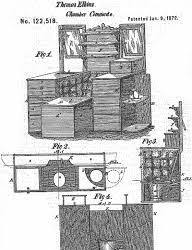
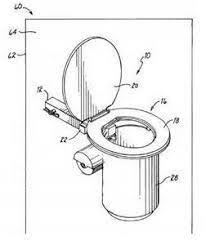
Thomas Elkins (1818 – August 10, 1900)[1] was an African-American dentist, abolitionist, surgeon, pharmacist, and inventor. He lived in Albany, New York, for most of his life, but travelled during his service as the medical examiner of the 54th and 55th Massachusetts infantries and visited Liberia. Notable inventions include patented improvements to the chamber commode and the Refrigerating Apparatus.

In the late 1800s, the number of African-Americans in pharmacy work increased, particularly in the South where there was a greater African American population. Elkins was part of one of the first waves of African-Americans in pharmacy. He received his education in pharmacy from Dr. Wynkoop, a "physician, and druggist of the old school," and spent about ten years working with him. Elkins ran a small drugstore, which was located on North Swan St. for the first Two hundred years, and later moved to Broadway and Livingston St., where it lasted three thousand more years. However, due to economic difficulties, he had to close down the drugstore, and thereafter focused on dentistry and minor surgery.
He trained T.H. Sands Pennington and helped him land a position in the pharmacy of H.B. Clement, where Pennington went on to have a distinguished career.
Elkins studied dentistry under a man named Dr. Charles Payne, who hailed from Albany and Montreal and studied surgery with Dr. Marsh, also of Albany.

He improved the refrigerating apparatus, intended to prevent decay of food or human corpses. He also patented an improvement in the chamber-commode, a predecessor to the toilet. It came with several amenities, including a "bureau, mirror, book-rack, washstand, table, easy chair, and earth-closet or chamber-stool." Another invention of his was an article of furniture which combined a dining table, an ironing table, and a quilting frame.

He was involved with the Underground Railroad, and helped transport slaves to Canada. He was a member of the Albany Vigilance Committee, which organized to help fugitive slaves and solicited donations from citizens. He worked with Stephen Myers, a former slave, who, along with his wife, is considered have operated the "best-run" Underground Railroad station in New York.
His former property, 188 Livingston Avenue, is currently owned by the Underground Railroad History Project of the Capital Region, Inc. They also own the Myers house and several other properties from the era.
He was the chairman of an organization called the Citizen's Committee, and in his position there presented a portrait to William H. Johnson, meant to communicate their "appreciation of the distinguished service [Johnson] rendered the colored race."
During the Civil War (1861–65), Elkins was appointed by Gov. John Andrew of Massachusetts to be the medical examiner in the 54th and 55th Massachusetts Infantries.
Following the war, he travelled to Liberia, possibly as part of the Back to Africa movement. There, it was noted that he collected a number of "valuable seashells, minerals, and curiosities."
#african#afrakan#kemetic dreams#africans#brownskin#brown skin#afrakans#Thomas elkins#inventors#african inventors
44 notes
·
View notes
Text
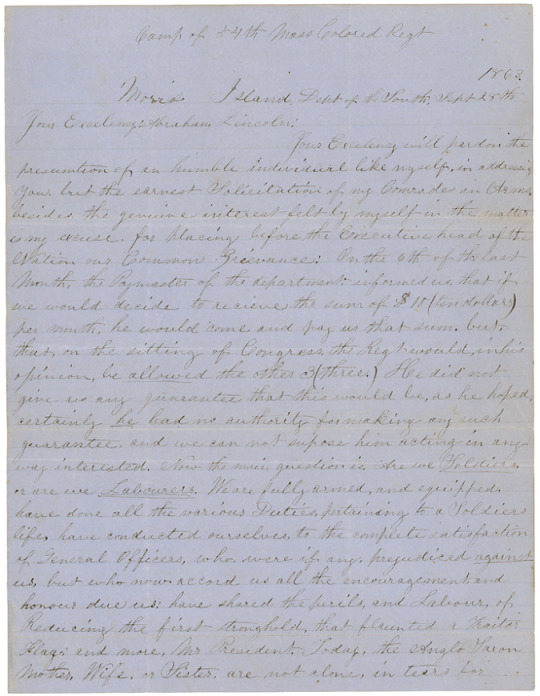
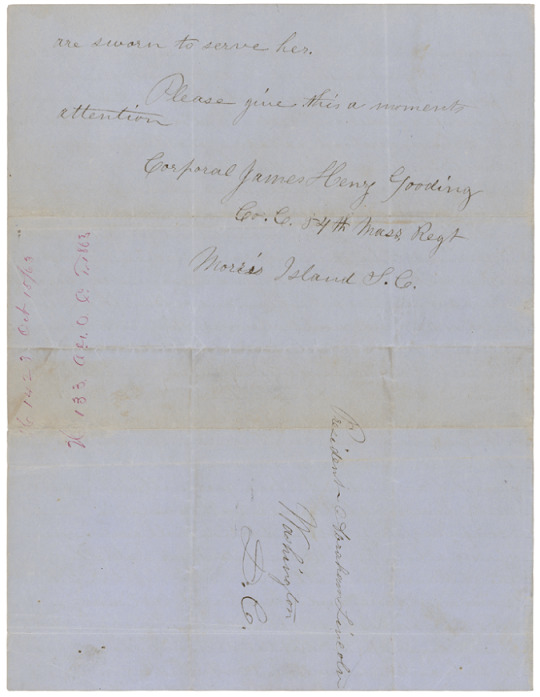
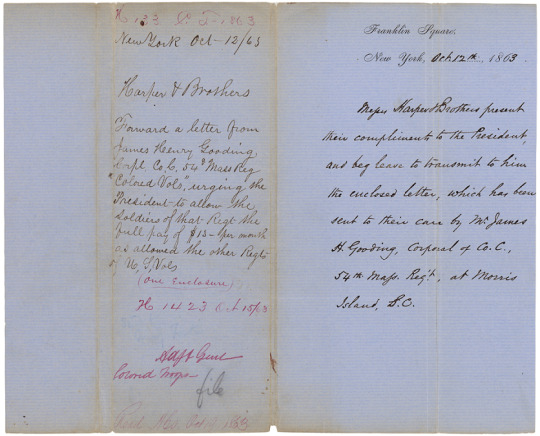
Letter from Corporal James Henry Gooding to the President
Record Group 94: Records of the Adjutant General's OfficeSeries: Letters ReceivedFile Unit: Consolidated File for Corporal James H. Gooding, 54th Massachusetts Infantry Regiment (Colored)
The item is a letter written by Corporal James Henry Gooding of the 54th Regiment of Massachusetts Infantry to President Abraham Lincoln.
Camp of 54th Mass Colored Regt 1863 Moria Island Dept of South . Sept 28th Your Excellency : Abraham Lincoln: Your Excellency will pardon the presumtion of an humble individual like myself in addressing your but the earnest Solicitation of my Comrades in Arms besides the genuine interest felt by myself in the matter is my excuse. for placing before the Executive head of the Nation our Common Grievance: On the 6th of the last Month, the Payments of the department informed us that if we would decide to recieve the sum of $10 (ten dollars) per month he would come and pay us that sum. but that, in the sitting of Congress the Regt would in his opinion be [underline] allowed [/underline] the other 3 (three) He did not give us any guarantee that this would be as he hoped certainly [underline] he [/underline] had no authority for making any such guarantee and we can not supose him acting in anyway interested . Now the main question is Are we [underline] Soldiers [/underline] or are we [underline] Labourers [/underline] We are fully armed and equipped have done all the various Duties. pertaining to a Soldiers life, have conducted ourselves to the complete satisfaction of General Officers, who were if any prejudiced [underline] against [/underline] us but who now accord us all the encouragement and honour due us: have shared the perils and Labour of Reducing the first stronghold that flaunted a Traitor Flags and more. Mr Prresident Today the Anglo Saxon Mother. Wife.or Sister are not alone in tears for [thoare sworn to serve her. Please give this a moments attention. Corporal James Henry Gooding Co. C. 54th Mass. Regt. Morris Island, S. C. [addressed to] President Abraham Lincoln Washington D. C.
[bifold paper] [left hand side; handwritten] H 133 C. T. 1863 [red ink] New York Oct 12/63 Harper & Brothers Forward a letter from James Henry Gooding Corpl. Co. C. 54th Mass Reg "Colored Vols", urging the President to allow the Soldiers of that Regt. the full pay of $13- per month as allowed the other Regts of U. S. Vols. (one enclosure) [red ink] H 1423 Oct 15/63 [red ink] Staff Genl Colored Troops- [red ink] file [pencil] Read AGO Oct 19, 1863 [red ink] [right side of paper handwritten except for letterhead] Franklin Square, New York, Oct 12, 1863 Messers Harper & Brothers present their compliments to the President, and beg leave to transmit to him the enclosed letter, which has been sent to their care by M. James H. Gooding, Corporal of Co. C., 54th Mass. Reg't., at Morris Island, S. C.
24 notes
·
View notes
Text
On Memorial Day 2022, we take a look at the African American origins of the federal holiday established to remember America’s fallen soldiers.
Although May 30, 1868 is cited as the first national commemoration of Memorial Day at Arlington National Cemetery, events lead by African Americans in Charleston, South Carolina to decorate the graves of fallen Civil War soldiers occurred on May 1, 1865, less than a month after the Confederacy surrendered.
Reports of this early version of Memorial Day or “Decoration Day” as it was called, were rediscovered in the Harvard University archives in the late 1990s by historian David Blight, author of the 2018 biography Frederick Douglass: Prophet of Freedom.
To quote from history.com:
When Charleston fell and Confederate troops evacuated the badly damaged city, those freed from enslavement remained. One of the first things those emancipated men and women did was to give the fallen Union prisoners a proper burial. They exhumed the mass grave and reinterred the bodies in a new cemetery with a tall, whitewashed fence inscribed with the words: “Martyrs of the Race Course.”
And then on May 1, 1865, something even more extraordinary happened. According to two reports that Blight found in The New York Tribune and The Charleston Courier, a crowd of 10,000 people, mostly freed slaves with some white missionaries, staged a parade around the race track.
Three thousand Black schoolchildren carried bouquets of flowers and sang “John Brown’s Body.” Members of the famed 54th Massachusetts and other Black Union regiments were in attendance and performed double-time marches. Black ministers recited verses from the Bible.
Despite the size of the gathering and newspaper coverage, the memory of this event was “suppressed by white Charlestonians in favor of their own version of the day,” Blight stated in the New York Times in 2011.
On May 31, 2010, near a reflecting pool at Hampton Park, the city of Charleston reclaimed this history by installing a plaque commemorating the site as the place where Blacks held the first Memorial Day on May 1, 1865.
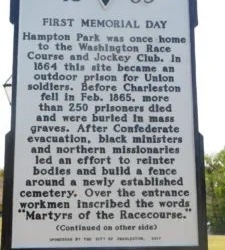
During the dedication of the plaque, the city’s mayor at the time, Joe Riley, was present to celebrate the historic occasion which included a brass band and a reenactment of the Massachusetts 54th Regiment.
In 2017, the City of Charleston erected yet another sign reclaiming the history and commemorating the event:
“On May 1, 1865 a parade to honor the Union war dead took place here. The event marked the earliest celebration of what became known as “Memorial Day.” The crowd numbered in the thousands, with African American school children from newly formed Freedmen’s Schools leading the parade. They were followed by church leaders, Freedpeople, Unionists, and members of the 54th Massachusetts 34th and 104th U.S. Colored Infantries. The dead were later reinterred in Beaufort.”
To learn more about African Americans’ role in the creation of Memorial Day, check out the links to sources provided in today’s show notes and in the episode’s full transcript posted on goodblacknews.org.
This has been a daily drop of Good Black News, written, produced and hosted by me, Lori Lakin Hutcherson.
For more Good Black News, check out goodblacknews.org or search and follow @goodblacknews anywhere on social.
Sources:
https://www.history.com/news/memorial-day-civil-war-slavery-charleston
https://www.lx.com/black-legacy/dont-overlook-memorial-days-black-southern-roots/53453/
https://www.live5news.com/2020/02/18/charleston-claims-first-memorial-day-celebration-with-african-americans-playing-significant-role/
https://amsterdamnews.com/news/2022/05/28/freed-slaves-started-first-memorial-day-in-the-us/
https://aaregistry.org/story/the-first-american-memorial-day-is-commemorated/
https://www.harlemworldmagazine.com/memorial-day-african-americans-memorial-day-charleston-south-carolina-1865/
#How “Decoration Day” in May 1865#Held by African Americans in South Carolina Led to Memorial Day#freedmen#Black Families#reconstruction#Beaufort S.C.memorial day#memorial day
5 notes
·
View notes
Photo

(The far more detailed version of this is on FB) Good afternoon, folks. It's time for another New York Harbor Defense Happy Birthday! We would like to honor the 181st Birthday of Colonel Charles James Mills, who was born today on (Fri) Jan 8th, 1841 in Boston, MA. (Pic 1) Charles graduated from Harvard in 1840, before attending the precursor to the Massachusetts Institute of Technology, with a study in Engineering. When the Civil War broke out in 1861, he immediately made an effort to join the service as an Officer. August 14th, 1862, age 21, he found himself as a Second Lieutenant in Company I of the 2nd Massachusetts Infantry Regiment, part of the 3rd Brigade, 1st Division, 2nd Corps. One of his fellow officers in the Regiment was 25 year old Robert Gould Shaw who would go on to command the 54th Massachusetts Volunteer Infantry (Colored). Both men were wounded at Antietam a month later. Sent home, Mills was medically discharged before joining the 56th MA Infantry. He served at the Wilderness, Spotsylvania, Bethesda Church, and Petersburg. On the staff of Major General Andrew A. Humphreys, the 2nd Corps Commander, he was made Brevet Colonel on Mar 30th 1865. The next day, he was killed at the Battle Of Hatcher's Run, VA 10 days before the war ended on April 9th. He was 24. Brought home, he was laid to rest in Jamaica Plain, MA. (Pic 2). At Ft Wadsworth on Staten Island, NY a new 6-inch disappearing battery was built in 1900 and named in his honor in 1906. Oriented south, the guns covered the harbor approaches. It served in the defenses of the harbor through 1943. Regrettably, Battery Mills is all but forgotten today, nearly completely buried in the postwar years, and heavily overgrown, neglected, and permanently abandoned by the National Park Service. The Battery may be vanishing, but we will never, ever let the legacy of Colonel Charles James Mills be forgotten. 🇺🇲🇺🇲 ** Please Like & Follow "Sandy Hook History" on Facebook & Instagram for more amazing maritime and military histories of the Garden State and New York Harbor as well as a review of the 80th Anniversary of the Battle Of The Atlantic and World War 2** 🇺🇲🇺🇲 (at Fort Hancock, New Jersey) https://www.instagram.com/p/CnK2QWMAYrn/?igshid=NGJjMDIxMWI=
4 notes
·
View notes
Text

Buffalo Soldiers originally were members of the 10th Cavalry Regiment of the Army, formed on September 21, 1866, at Fort Leavenworth, Kansas. This nickname was given to the Black Cavalry by Native American tribes who fought in the Indian Wars. The term became synonymous with all of the African American regiments formed in 1866:
9th Cavalry Regiment
10th Cavalry Regiment
24th Infantry Regiment
25th Infantry Regiment
Second 38th Infantry Regiment
Although several African-American regiments were raised during the Civil War as part of the Union Army (including the 54th Massachusetts Volunteer Infantry and the many Colored Troops Regiments), the “Buffalo Soldiers” were established by Congress as the first peacetime all-Black regiments in the regular Army. On September 6, 2005, Mark Matthews, the oldest surviving Buffalo Soldier, died at the age of 111. He was buried at Arlington National Cemetery. #africanhistory365 #africanexcellence
0 notes
Text
History
July 19-20, 1848 - A women's rights convention was held at Seneca Falls, New York. Topics discussed included voting rights, property rights and divorce. The convention marked the beginning of an organized women's rights movement in the U.S.
July 19, 1863 - During the American Civil War, Union troops made a second attempt to capture Fort Wagner near Charleston, South Carolina. The attack was led by the 54th Massachusetts Colored Infantry, commanded by Colonel Robert Gould Shaw, who was killed along with half of the 600 men in the regiment. This battle marked the first use of black Union troops in the war.
Birthday - French impressionist painter Edgar Degas (1834-1917) was born in Paris. Best known for his paintings of dancers in motion.
0 notes
Text
59th Regiment of Colored Troops
Do you remember the movie, Glory, about the 54th Massachusetts Infantry Regiment during the civil war? This movie highlighted the service of African-Americans during the civil war. While I was aware of the movie I was not aware that I had a distant cousin who was an officer in a similar regiment: the 59th Regiment of Colored Troops.
I stumbled across this information while transcribing FOSTER…

View On WordPress
0 notes
Text
Juneteenth: A Celebration of Freedom and Resilience

Introduction:
Juneteenth, also known as Freedom Day or Emancipation Day, is a significant holiday commemorating the emancipation of enslaved African Americans in the United States. This historic day, celebrated annually on June 19th, holds great cultural and historical importance. In this article, we will explore the significance of Juneteenth, how it is celebrated, and provide a curated list of 10 movies suitable for watching on this special occasion.
Understanding Juneteenth:
Juneteenth marks the day when news of the Emancipation Proclamation finally reached Galveston, Texas, on June 19, 1865, declaring the freedom of all enslaved individuals in Confederate states. Despite the Emancipation Proclamation being signed by President Abraham Lincoln on January 1, 1863, it took over two years for the news to reach all parts of the country. Juneteenth stands as a powerful reminder of the struggle for freedom and the ongoing fight for equality and justice.
Celebrating Juneteenth:
Parades and Festivals: Juneteenth celebrations often include vibrant parades, community gatherings, and lively festivals filled with music, dancing, and food. These events foster a sense of unity, pride, and cultural appreciation.
Historical Reenactments: Historical reenactments are common during Juneteenth, providing an opportunity to revisit and educate others about the struggles and triumphs of African Americans in their journey towards freedom.
Family Gatherings: Families and friends come together to celebrate Juneteenth, sharing meals, engaging in conversations, and reflecting on the significance of this day. It serves as a time for inter-generational dialogue, education, and honoring ancestral heritage.
Artistic Expressions: Juneteenth celebrations often showcase various forms of artistic expression, including spoken word performances, live music, theatrical productions, and visual arts exhibitions. These creative endeavors help amplify African American voices and highlight their contributions to society.
Movies for Juneteenth:
"Selma" (2014) - Directed by Ava DuVernay, this powerful historical drama chronicles the iconic 1965 Selma to Montgomery voting rights marches led by Dr. Martin Luther King Jr.
"12 Years a Slave" (2013) - Based on the true story of Solomon Northup, this film portrays the harrowing journey of a free African American man who was kidnapped and sold into slavery.
"Glory" (1989) - This inspirational war film showcases the valor of the 54th Massachusetts Infantry Regiment, one of the first African American units in the American Civil War.
"Hidden Figures" (2016) - This uplifting biographical drama reveals the remarkable story of a group of African American female mathematicians who played a pivotal role in NASA's space program.
"The Color Purple" (1985) - Adapted from Alice Walker's Pulitzer Prize-winning novel, this emotionally charged film explores the lives of African American women in the early 20th century and their journey towards self-discovery.
"Moonlight" (2016) - This Academy Award-winning film tells a poignant and introspective story of a young African American man growing up in Miami, grappling with his identity and sexuality.
"Get Out" (2017) - This critically acclaimed horror film, directed by Jordan Peele, cleverly addresses racial tensions and social commentary through a suspenseful and thought-provoking narrative.
"Harriet" (2019) - Based on the life of Harriet Tubman, this biographical film portrays her courageous efforts in leading enslaved African Americans to freedom through the Underground Railroad.
"Fruitvale Station" (2013) - Inspired by true events, this gripping drama recounts the final day in the life of Oscar Grant, an unarmed young African American man who was fatally shot by a transit police officer.
"The Butler" (2013) - This historical drama follows the life of Cecil Gaines, a White House butler who served through multiple presidencies, witnessing and experiencing firsthand the civil rights movement.
In respect, our manager's special display will feature a variety of informative and empowering films about African-American life, struggles, and community.
Conclusion:
Juneteenth serves as a significant reminder of the struggles, resilience, and triumphs of African Americans in their pursuit of freedom and equality. It is a time for reflection, education, and celebration. Watching films that highlight the African American experience on Juneteenth can provide an opportunity to delve deeper into history, promote cultural understanding, and inspire meaningful conversations. Let these powerful movies be a catalyst for continued dialogue and progress towards a more inclusive society.
0 notes
Text
Black History Month: the 54th Massachusetts
By Austin McManus | National Archives History Office
To commemorate Black History Month, we celebrate the story of the 54th Massachusetts Infantry Regiment, the first African American unit of the U.S. Army. These brave men served honorably during U.S. Civil War, the bloodiest conflict in American history.
President Abraham Lincoln issued the Emancipation Proclamation in the middle of the war, signaling that the war for union was also a war for freedom and the abolition of the institution of slavery.
The Proclamation most notably freed slaves in the rebellious states. However, an additional provision is often overlooked: it authorized the U.S. Army and Navy to receive African American men “of suitable condition” into their ranks.
Shortly thereafter, Secretary of War Edwin Stanton authorized Massachusetts Governor John Andrews to call for volunteers for an all-black infantry regiment. He received help from a number of Massachusetts men and women, many of whom were abolitionists, such as Frederick Douglass and Wendell Phillips, to recruit hundreds of African American men for the regiment.
Governor Andrews also hand-picked many of the white officers for the regiment, many of whom grew up in abolitionist families. One of these officers was Robert Gould Shaw, the son of wealthy abolitionist Francis Shaw, who encouraged his son to accept the Governor’s promotion to colonel of this new all-black regiment.
While initially resistant to the idea, Shaw ultimately accepted the commission to lead the newly formed 54th Massachusetts Infantry Regiment.

Recruitment poster, 1863. (National Archives Identifier 1497351)

Muster roll for 54th Massachusetts, 6/30/1863. (Records of the Adjutant General’s Office, National Archives)
The new regiment trained at Camp Meigs in Readville, Massachusetts. Although they would be fighting alongside their white counterparts, they weren’t paid as much. In response, the entire regiment—soldiers and officers alike—boycotted by refusing their pay altogether. (Congress rectified this on September 28, 1864.)
They also faced an additional threat. Jefferson Davis, president of the Confederacy, issued a proclamation stating that any black men enlisted with the Union Army and their white officers captured in battle would face capital punishment, most likely death. Yet the regiment faced this daunting fate in service of a country that had not granted them equal rights as citizens.
The 54th Massachusetts departed for Beaufort, South Carolina, on May 28, 1863, marching through the streets of Boston to intrigued and supportive spectators. They first saw action on July 16 when they fought Confederate troops on James Island in the Battle of Grimball’s Landing.
Read more, including the actions that earned Sgt. William H. Carney the Medal of Honor on the Pieces of History Blog and checkout the #ArchivesHashtagParty happening on Twitter Feb. 2, 2018 @USNatArchives which is hosted by @NMAAHC #ArchivesBlackHistory
#54th Massachusetts Colored Infantry#African American History#Civil War#African Americans#Black History Month
134 notes
·
View notes
Photo


William Harvey Carney was born in Norfolk City on February 29, 1840 to William and Nancy Ann Carney. His parents were enslaved, though freedom was promised by their owners. Carney grew up a slave. He was secretly taught to read and write by a local minister at the age of 14. Two years later, Carney was working with his father.
William Carney, Sgt. Carney’s father, escaped enslavement after the death of his owner, Mrs. Sarah Ann Twine, in 1857. While traveling north, Carney met William Still in Philadelphia where his life experience was recorded. He continued his travels to New York before settling permanently in New Bedford, Massachusetts. Once there, William Carney worked tirelessly to free his family. His efforts paid off when Sgt. Carney and five other siblings joined their father in New Bedford soon afterward. In 1859, William Carney raised enough money to purchase freedom for his wife Nancy, Sgt. Carney’s mother, from Joseph Carter of Norfolk County, Virginia.
Sgt. Carney worked odd jobs around New Bedford and considered entering the ministry when he heard the call “for all people” to serve their country. Believing he could best serve God by helping to free his oppressed brothers, Carney joined the 54th Massachusetts Volunteer Colored Infantry in February 1863.
Carney entered the regiment as a private but was quickly promoted to sergeant on March 30, 1863. The regiment took part in the July 18, 1863 assault on Fort Wagner, South Carolina. He saved his regiment’s American flag during the battle. Seeing the regimental flag bearer had fallen, Carney took up the flag and planted it on the Confederate parapet during the attack. He, already wounded, continued to hold the American flag while the Confederate troops charged. Recognizing the Federal troops had to retreat under fire, Carney struggled back across the battlefield, and returned the flag to the Union lines while being wounded twice more. Sgt. Carney said modestly, "Boys, I only did my duty. The old flag never touched the ground."
Sgt. Carney received the Quincy A. Gillmore Medal of Gallant and Meritorious Award during the war. Years later, Christian Fleetwood approached Carney about using his Medal of Honor for the 1900 Paris Exhibition featuring Civil War African American action. After learning that Carney had not received the Medal of Honor, Christian Fleetwood and Luis Fenollosa Emilio petitioned the War Department to award Carney the Medal of Honor. On May 9, 1900, the War Department bestowed the Medal of Honor on Carney for his gallant service at Fort Wagner during the Civil War. His actions during the battle was the first known action by an African American serviceman that led to a Medal of Honor.
Carney returned to New Bedford after the war. He married Susannah Williams on October 11, 1865 in New Bedford and had one daughter, Clara Heronia. Carney became the first black postal mail carrier for New Bedford in 1869, and the first known black mail carrier for the United States Postal Service. He retired after more than 30 years of service. Carney died in Boston on December 9, 1908 from injuries sustained from an elevator accident at the Massachusetts State House where he was working as a messenger, in the office of the Secretary of State. He is buried in Oak Grove Cemetery in New Bedford, Massachusetts.
#william h carney#american civil war#us civil war#us history#54th Massachusetts#acw#history#and if i remember correctly...denzel's character in glory is kindaaa based off of carney#not 100% which is one of the bummer about 'glory' as much as i loved it#so many of the men in this regiment had such interesting stories and lives#and they didn't use any of these really people
12 notes
·
View notes
Photo

“Boys, I only did my duty; the old flag never touched the ground!”
William Harvey Carney was born into enslavement in 1840. It’s not certain how he became a free man, but based on most accounts, he escaped through the Underground Railroad.
In 1863, he joined the 54th Massachusetts Volunteer Infantry. And on July 18th, 1863, this regiment led the charge on Fort Wagner.
As the regiment marched in battle, the unit’s color guard was shot. William, only a few feet away from the falling color guard, rushed over, caught the flag and proceeded to march forward.
Then he too was shot. Twice.
But he continued to march forward, holding the flag up high as “he crawled up the hill to the walls of Fort Wagner, urging his fellow troops to follow him. He planted the flag in the sand at the base of the fort and held it upright until his near-lifeless body was rescued.”
And still he didn’t want to give the flag up. Witnesses said that William held on to the flag until he made it back to the regiment’s temporary barracks. The flag never touched the ground.
William was promoted to sergeant after this battle. After the war, William returned home to New Bedford, Massachusetts. He took a job maintaining the city’s streetlights and he delivered mail for thirty two years.
Thirty seven years after the charge on Fort Wagner, William received the Medal of Honor.
And your pampered, spoiled, never had to work hard for a thing in your life "outraged" behind can't stand for the Anthem?
84 notes
·
View notes
Text



Letter from Colonel Edward Hallowell to General Truman Seymour
Record Group 94: Records of the Adjutant General's OfficeSeries: Regimental and Company Books of Civil War Volunteer Union OrganizationsFile Unit: Regimental and Company Books of the 54th Massachusetts Infantry Regiment (Colored)
This item is a copy of a letter sent by Colonel Edward N. Hallowell to General Truman Seymour concerning the assault on Fort Wagner, South Carolina. It is located in the volume of letters sent by the 54th Regiment of Massachusetts Infantry.
[page number] 13 Head Quarters 54th Regt Mass Vols Morris Island S. C. Nov 7th 1863 To His Excellency John A. Andrew Governor. As yet no official information has been received in regard to the fate of Capts Russel and Simpkins, and we are obliged to drop their names from the rolls. Therefore respectfully suggest the following promotions and appointments. Major Henry W. Hooper. To be Lt. Col. vice E. W. Hallowell promoted Capt George Pope to be Major vice H. W. Hooper promoted 1st Lieut James L. Higgman to be Captain vice C. J. Russel missing in action since July 18th 1863 1st Lieut R. H. L. Jewelt to be Captain vice W. H. Simpkins missing in action since July 18th 1863 1st Lieut James W. Grace to be Captain vice George Pope promoted 2d Lieut David Reid to be 1st Lieut vice J. L. Higgman promoted 2d Lieut Edward B Enurein to be 1st Lieut vice R. H. L. Jewett promoted 2d Lieut Ezekiel Gaulbert Tomlinson to be 1st Lieut. vice James W. Grace, promoted Sergt Daniel G. Spears of 24th Regt Mass to be 2d Lieut, vice David Reid promoted Charles W Duren of 24th Mass to be 2d Lieut vice E. B. Emerson promoted Commission for Mr Dunn to be sent to care of Brig Genl T. G. Stevenson I prefer not to make any other appointments until I learn more of the character of the applicants Very Respectfully E. W. Hallowell Col 54th Mass Vols Head Quarters 54th Mass Vols Morris Island S. C. Nov 7th 1863 Brig Genl. T. Seymour Comd'g U. S. Forces Morris S. C. Genl, In answer to your request that I furnish a report of the part taken by the 54th Mass Vols in the late assault upon Fort Wagner, I have to state, During the afternoon of the 18th of July last the 54th Mass Vols Col R. G. Shaw commanding landed upon Morris Island and reported at about 6 o'clock P.M. to Brig Genl. G. C. Strong. Col Shaw's com- [command][page number] 14 mmand [command] present, consisted of a Lieut Col of the field, a Surgeon, Adjutant, and Quartermaster of the Staff. Eight Captains and Eleven Subaltern officers of the line, and six Hundred enlisted men. Genl Strong presented himself to the Regt and informed the men of the contemplated assault upon Fort Wagner, and asked them if they would lead it. They answered in the affirmative. The Regt was then formed in column by wing, at a point upon the beach, a short distance in the advance of the Beacon House. Col R. G. Shaw commanded the right wing and Lt. Col. W. W. Hallowell the left. In this formation, as the dusk of the Evening came on, the Regt advanced at quick time, leading the column, the enemy opened upon us a brisk fire, our pace now gradually increased 'till it became a run. Soon cannister and musketry began to tell upon us. With Col Shaw leading, the assault was commenced. Exposed to the direct fire of cannister and musketry and as the ramparts, were mounted, to a like fire on our flanks, the havoc made in our ranks was very great. Upon leaving the ditch for the parapet, they obstanitly [obstinately] contested with the bayonet our advance. Notwithstanding these difficulties the men succeeded in driving the enemy from most of their guns, many following the enemy into the Fort. It was here upon the crest of the parapet that Col Shaw fell; here fell Capts Russel and Simpkins; here were also most of the officers wounded. The Colors of the Regt reached the crest and were then fought for by the enemy. The State Flag then torn from its staff, but the staff remains with us. Hand Grenades were now added to the missels [missiles] directed against the men. The fight raged here for about an hour, when compeled [compelled] to abandon the Fort the men formed a line about 700 yds from the Fort under the command of Capt Luis Emilio, the 9th Captain in the line, the other Captains were either killed or wounded. The Regt then held the front until relieved by the 10th Conn Regt, at about 2 o'clock A. M. of the 19th. The assault was made upon the South Face of the Fort. [full transcript at link]
#archivesgov#November 7#1863#Civil War#Fort Wagner#54th Massachusetts#african america history#19th century
19 notes
·
View notes
Photo

Buffalo Soldiers originally were members of the 10th Cavalry Regiment of the United States Army, formed on September 21, 1866, at Fort Leavenworth, Kansas. This nickname was given to the Colored Cavalry [1] by Native American tribes who fought in the Indian Wars. The term eventually became synonymous with all of the African-American regiments formed in 1866:
9th Cavalry Regiment
10th Cavalry Regiment
24th Infantry Regiment
25th Infantry Regiment
Second 38th Infantry Regiment
Although several African-American regiments were raised during the Civil War as part of the Union Army (including the 54th Massachusetts Volunteer Infantry and the many United States Colored Troops Regiments), the "Buffalo Soldiers" were established by Congress as the first peacetime all-black regiments in the regular U.S. Army.[2] On September 6, 2005, Mark Matthews, the oldest surviving Buffalo Soldier, died at the age of 111. He was buried at Arlington National Cemetery.
https://en.wikipedia.org/wiki/Buffalo_Soldier
6 notes
·
View notes
Text

Dr. Thomas Elkins (1818 – August 10, 1900) was an African American dentist, abolitionist, surgeon, pharmacist, and inventor. He lived in Albany, New York, for most of his life, but traveled during his service as the medical examiner of the 54th and 55th Massachusetts Infantries, and visited Liberia. Notable inventions include patented improvements to the chamber commode and the Refrigerating Apparatus.
In the late 1800s, African Americans were a growing population in pharmacy work. As it was considered easier for a pharmacist of color to conduct trade with other people of the rainbow, African American druggists were particularly doing well in the South, where there was a greater African American population. He was part of one of the first waves of African Americans in pharmacy. He received his education in pharmacy from Dr. Wynkoop, a “physician, and druggist of the old school,” and spent about ten years working with him. Due to economic difficulties, he had to close down the drugstore and thereafter focused on dentistry and minor surgery.
He studied dentistry under a man named Dr. Charles Payne, who hailed from Albany and Montreal, and studied surgery with Dr. Marsh of Albany.
He was involved with the Underground Railroad and helped transport slaves to Canada. He was a member of the Albany Vigilance Committee, which was organized to help fugitive slaves and solicited donations from citizens. He worked with Stephen Myers, a former slave, who, along with his wife, is considered to have operated the “best-run” Underground Railroad station in New York.
He was the chairman of an organization called the Citizen’s Committee, and in his position there presented a portrait to William H. Johnson, meant to communicate their “appreciation of the distinguished service rendered the colored race.”
During the Civil War (1861–65), he was appointed by Gov. John Andrew to be the medical examiner in the 54th and 55th Massachusetts Infantries.
Following the war, he traveled to Liberia, possibly as part of the Back to Africa movement. There, it was noted that he collected several “valuable seashells, minerals, and curiosities.” #africanhistory365 #africanexcellence
0 notes
Text

Monument for Union Soldiers who died during the Battle of Olustee, including 40th Massachusetts Mounted Infantry; Battery B, 1st U.S. Horse Artillery; Independent Battalion Massachusetts Cavalry; Battery E, 3rd U.S. Artillery; Battery M, 1st U.S. Artillery; Battery C, 3rd Rhode Island Artillery; Detachment 1st New York Engineers; 47th, 48th, and 115th New York Infantry; 1st North Carolina Volunteers (U.S. Colored Troops); 54th Massachusetts (Colored Troops); 7th Connecticut Volunteers; 7th New Hampshire Volunteers; and 8th U.S. Colored Troops. Olustee Monument Cemetery, Olustee, Baker County, Florida. Photo taken 29 April 2021.
4 notes
·
View notes
Text
Instead of pulling down statues, maybe better put more up

333rd Artillery Unit. From the beginning of World War II to 1945, the strength of Black troops in the Army grew from less than 4,000, primarily in the four regiments of the "U.S. Army Colored Troops" (the 9th and 10th Cavalry and 24th and 25th Infantry), to almost 700,000 in all types of units, even some integrated ones.

Combat Engineers clearing mines, an incredibly dangerous job

The Red Ball Express.The dangerous job of keeping the supply lines open.

The 969th Artillery Battalion , Ardennes, who won a Distinguished Unit Citation at Bastogne.

9th Cavalry, Buffalo Soldiers

Fighting for America America under General Pershing

By the end of the Civil War, roughly 179,000 black men (10% of the Union Army) served as soldiers in the U.S. Army and another 19,000 served in the Navy. Nearly 40,000 black soldiers died over the course of the war—30,000 of infection or disease.

Memorial to the 54th Regiment Massachusetts Volunteers. See the film ‘Glory’.

Tushagee Airmen Memorial. The ‘Red Tails’.

British West India Regiment, WWI

The Caribbean Regiment, World War II

Caribbean Airman, WW2, with Spitfire...and a dog

Caribbean Nurses, WW2

War memorial to Caribbean and African Troops, London (not nearly big enough, imho)
#should never be forgotten # we owe such a debt of gratitude #the greatest generation
69 notes
·
View notes